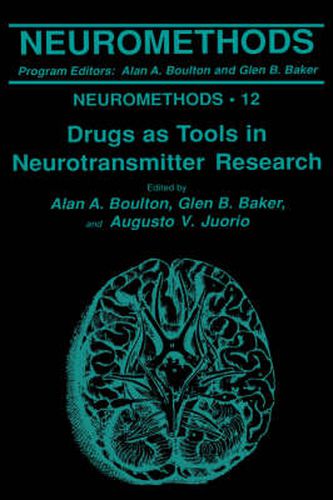Readings Newsletter
Become a Readings Member to make your shopping experience even easier.
Sign in or sign up for free!
You’re not far away from qualifying for FREE standard shipping within Australia
You’ve qualified for FREE standard shipping within Australia
The cart is loading…






This title is printed to order. This book may have been self-published. If so, we cannot guarantee the quality of the content. In the main most books will have gone through the editing process however some may not. We therefore suggest that you be aware of this before ordering this book. If in doubt check either the author or publisher’s details as we are unable to accept any returns unless they are faulty. Please contact us if you have any questions.
Serendipitous discovery has played an important role m the identification of physiological mechanisms in central and peri- eral neurotransmission. In many cases, the subsequent followup of these discoveries has been substantially aided by previouslyiden- fied natural substances that interfered with these mechanisms. The site of neuromuscular blockade produced by curare extracts, for example, was shown in the 1850s by Claude Bernard, and Sir Henry H. Dale m 1906 discovered the reversal of the pressor effects of adrenal extracts by ergot alkaloids. These findings were the first clues that led eventually to the definition of mcotinic cholinergic receptors and the present classification of adrenergic receptors. In the 1950s many discoveries, including the identification of the catecholamines and 5-hydroxytryptamine in the central n- vous system, followed by the development of specific sensitive biochemical and histochemical methods and the introduction of modern psychotropic drugs led to our increased understanding of chemical transmission and the formulation of theories that attempt to explain the causes of some mental disorders. The finding that hydroxylated derivatives of noradrenaline and- hydroxytryptamine are readily taken up by catecholaminergic or serotonergic neurons, and that this is followed by poisoning and death of the cell, encouraged the use of these compounds for the mapping of central and peripheral catecholamine or- hydroxytryptamine systems, and the mvestigation of the re- vance of these pathways to receptor regulation or behavioral - sponses.
$9.00 standard shipping within Australia
FREE standard shipping within Australia for orders over $100.00
Express & International shipping calculated at checkout
This title is printed to order. This book may have been self-published. If so, we cannot guarantee the quality of the content. In the main most books will have gone through the editing process however some may not. We therefore suggest that you be aware of this before ordering this book. If in doubt check either the author or publisher’s details as we are unable to accept any returns unless they are faulty. Please contact us if you have any questions.
Serendipitous discovery has played an important role m the identification of physiological mechanisms in central and peri- eral neurotransmission. In many cases, the subsequent followup of these discoveries has been substantially aided by previouslyiden- fied natural substances that interfered with these mechanisms. The site of neuromuscular blockade produced by curare extracts, for example, was shown in the 1850s by Claude Bernard, and Sir Henry H. Dale m 1906 discovered the reversal of the pressor effects of adrenal extracts by ergot alkaloids. These findings were the first clues that led eventually to the definition of mcotinic cholinergic receptors and the present classification of adrenergic receptors. In the 1950s many discoveries, including the identification of the catecholamines and 5-hydroxytryptamine in the central n- vous system, followed by the development of specific sensitive biochemical and histochemical methods and the introduction of modern psychotropic drugs led to our increased understanding of chemical transmission and the formulation of theories that attempt to explain the causes of some mental disorders. The finding that hydroxylated derivatives of noradrenaline and- hydroxytryptamine are readily taken up by catecholaminergic or serotonergic neurons, and that this is followed by poisoning and death of the cell, encouraged the use of these compounds for the mapping of central and peripheral catecholamine or- hydroxytryptamine systems, and the mvestigation of the re- vance of these pathways to receptor regulation or behavioral - sponses.